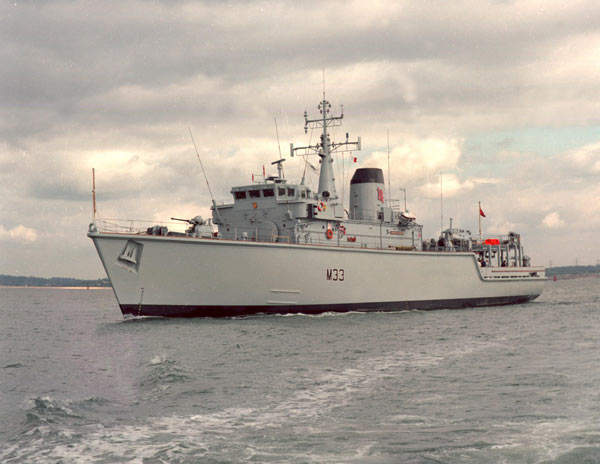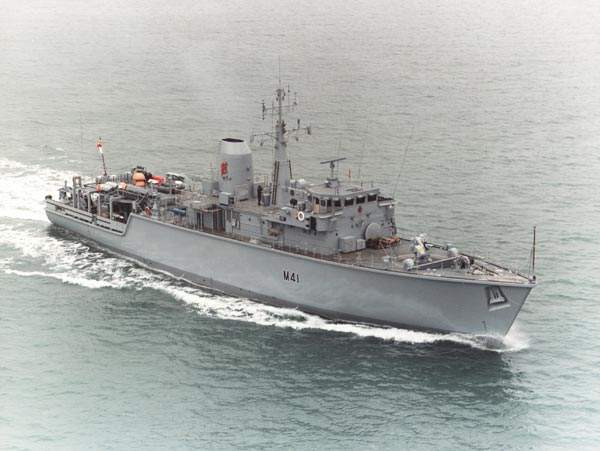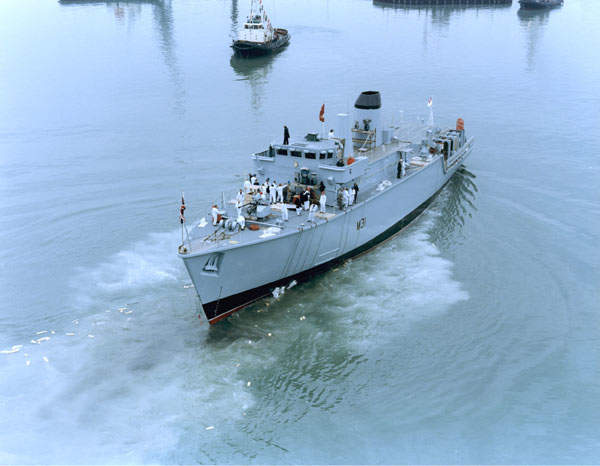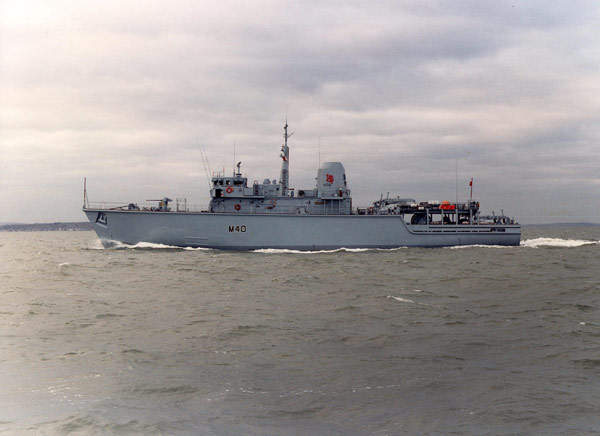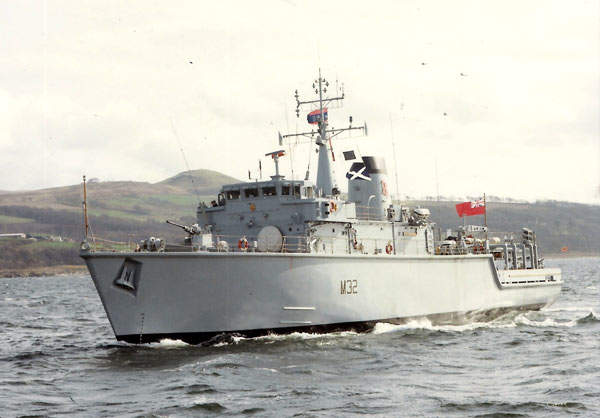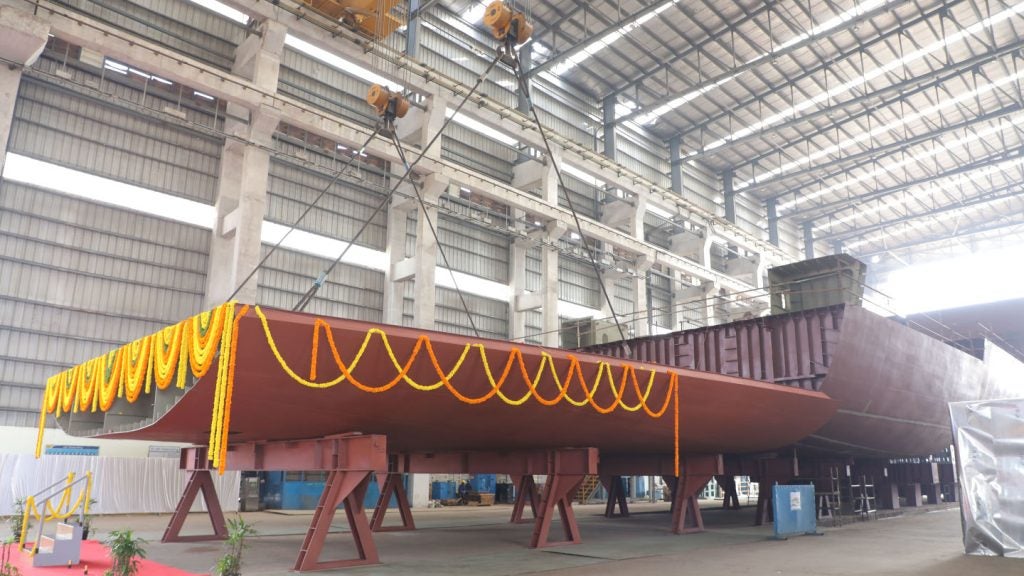Between 1980 and 1989, 13 Hunt Class minesweepers and minehunters of the UK’s Royal Navy were commissioned. Eight remain in service with the Royal Navy and are being significantly upgraded.
HMS Ledbury (M30), Cattistock (M31), Brocklesby (M33), Chiddingfold (M35), Atherstone (M38), Hurworth (M39) and Quorn (M41) were built by Vosper Thorneycroft at Woolston. HMS Middleton (M34) was built by Yarrow Shipbuilders in Glasgow. The vessels are based at Portsmouth and Faslane.
Two vessels, Bicester (M36) and Berkely (M40), have been transferred to the Greek Navy and renamed Europa and Callisto.
Brecon (M29), Cottesmore (M32) and Dulverton (M35) had mine countermeasures systems removed and were used as Northern Ireland Patrol Ships. The three vessels were decommissioned in September 2005. Brecon was used as a training ship.
In November 2008, the UK Ministry of Defence signed an agreement with Lithuania for the refit and upgrade of Cottesmore and Dulverton. The two vessels were refurbished and fitted with mine hunting equipment by December 2010. Thales Naval was the prime contractor for the conversion. The refit was completed by A&P Group on behalf of Thales Naval. The vessels entered service with the Lithuanian Navy by 2011.
Design
At 750t displacement, 60m length, 10.5m beam and 2.2m draught, the Hunt Class are the largest warships of glass-reinforced plastic (GRP) construction. The GRP construction contributes to the vessel’s very low magnetic signature, which is required for mine countermeasures operations. The vessel has a crew of 45 with five officers.
Mine countermeasures
The vessels were designed for both minesweeping and minehunting and also for patrol missions. A two-man decompression chamber is installed for the safety of the mine clearance divers. The Royal Navy’s clearance divers are capable of diving to depths of 80m.
The vessels were originally fitted with minesweeping systems that required the vessels to enter potential minefields in order to deploy them. The minesweeping systems fitted were the non-magnetic wire sweep mk8 (WS 8), which was streamed either as a single ship Oropesa or as a team sweep, and the combined influence sweep, which combined a minesweeping system acoustic mk1 (MSSA 1) and a magnetic sweep mk14 buoyant loop (MS 14).
The towed loop of the Hunt Class vessels takes a significant time to deploy and also restricts the movement and manoeuvrability of the ship. The sweep systems have been removed but can be reinstalled at 30 days’ notice. Sweep systems have been used by the Royal Navy for 100 years and the final deployment of sweep gear by the Royal Navy was carried out in October 2005 off the coast of the Isle of Wight by HMS Ledbury (M30).
The Atlas-QED consortium, led by Atlas Elektronik of Newport, Wales, with EDO Corporation and QinetiQ, was awarded a £5m research contract in July 2007 to build a system demonstrator that could enable the Royal Navy to replace the Hunt Class combined influence sweep system.
The demonstrator programme is called flexible agile sweep technology (FAST). The demonstrator is a small 9m-long vessel, such as a rigid inflatable boat. The Hunt Class can carry two of the production variant craft.
The craft will generate magnetic and acoustic signals which an intelligent hostile mine would identify as the signatures of a large vessel. They could be controlled from the Hunt Class, another suitable platform or from the shore and would enable the ship to carry out minehunting and minesweeping simultaneously.
Equipment trials with the demonstrator vehicles were conducted on HMS Ledbury in mid 2009.
Mine disposal vehicles
The vessels are equipped with two Eca PAP 104 mk3 remotely controlled mine disposal vehicles for the identification and disposal of mines. The PAP systems are accurately manoeuvred using a portable joystick control. From 2007 to 2009, the PAP systems were replaced by the Seafox C expendable mine-disposal vehicle which is effective against short and long tethered mines, proud sea-bed mines and floating mines.
The UK Ministry of Defence’s Defence Logistics Organisation awarded the contract to Ultra Electronics Group in January 2006 to supply the Seafox C expendable vehicle. Ultra is the prime contractor and is teamed with the German company Atlas Elektronik, designer and manufacturer of Seafox, and the UK company Babcock Design and Technology, responsible for the ship-fitting and logistics support. HMS Atherstone and HMS Chiddingfold successfully completed sea trials with Seafox in February 2008 followed by HMS Brocklesbury in January 2009. Seafox entered service in 2008.
The Hunt Class is fitted with an Easytrack subsea acoustic tracking system from Applied Acoustic Engineering, based in Norfolk. The Easytrack system is integrated as part of the Seafox mine disposal system. Easytrack uses ultra-short baseline tracking (USBL).
The Easytrack transducer has closely spaced elements producing an ultra short baseline wavelength signal for precise short-range high-resolution performance. The transducer is fitted with pitch and roll sensors to compensate for vessel movement as well as a magnetic compass for heading calculations.
When a mine is located, the Seafox C expendable vehicle is launched from the Hunt Class vessel.
The expendable vehicle is of small size, length 1.3m and weight 40kg. The expendable vehicle is guided toward the mine either automatically or manually with a control console on the mother ship.
The control console is linked via a fibre-optic cable to the Seafox’s onboard high-frequency location sonar and CCTV television sensors. Seafox is fitted with a shaped charge explosive warhead to dispose of the targeted sea mine.
The vehicle is fitted with four independent and reversible motors and a hover thruster to provide manoeuvrability and precision positioning near to the targeted mine in order to accurately and safely fire the shaped charge.
Sensors
The Hunt Class surface warning and navigation radar is the Kelvin Hughes Type 1007 naval radar operating at I-band.
The Hunt Class is fitted with the Thales Sonar 2193 hull-mounted wide band sonar. In 2001, Thales UK in Templecombe was awarded the contract for the overall system design, integration, installation and sea acceptance trials of the 2193 sonar and the upgraded Nautis 3 command systems on the Hunt class vessels. Sonar 2193, which entered service in 2004, emits an acoustic signal covering a wide range of frequencies in the 100kHz to 300kHz bands. The multifrequency operation provides increased range coverage and accuracy for mine detection and classification compared to the performance of conventional single frequency sonars.
Sea trials demonstrated the 2193 minehunting capability with the detection and classification of very low target strength objects at considerably greater ranges than previously achieved and in difficult coastal water conditions. The 2193 sonar has the capability to detect and classify an object the size of a football at a range up to 1,000m.
Command and control
The vessels are fitted with the BAE Systems Insyte (formerly Alenia Marconi Systems) Nautis M combat management system. The Nautis 3 software upgrade, installed as part of the Hunt mid-life update programme, includes mine countermeasures mission software for controlling navigation, mine detection, classification, remote disposal and ship manoeuvring.
The upgrade also included DRS Technologies OPUS 2 multifunction display consoles.
Weapons
The Hunt Class vessels’ main armament is the MSI DS 30B 30mm naval gun which can be set to fire 0.36kg shells in single-shot or burst firing up to 650 rounds a minute.
The range of the gun is 20km against surface targets and 3km against airborne targets. The DS30B is one of the MSI DS25/30 series, and is gyro stabilised, and electrically operated. The gun has low magnetic, radar and infrared signatures.
The Hunt Class was fitted with the Dillon Aero M134 minigun close-in weapon system in 2007. The M134 is a 7.62mm six-barrelled minigun capable of fixed firing rates of 3,000 rounds a minute.
Engines
The Hunt Class vessels are fitted with two 1.42MW Ruston-Paxman 9-59K Deltic diesel engines driving two shafts. The maximum speed is 15kt. A Deltic 0.582MW 9-55B diesel provides pulse generation and auxiliary power. Bow thrusters are fitted for manoeuvrability and precise station keeping. The vessels have a range of 1,500nm.
In October 2010, BAE Systems signed a £15m contract to replace the 30-year-old propulsion systems onboard eight Royal Navy Hunt Class vessels. All vessels will be fitted with new engines, gearboxes, bow thrusters, propellers and machinery control systems by 2016 as part of the contract.
The Global Naval Surface Combatants and Warfare Systems Market 2011-2021
This project forms part of our recent analysis and forecasts of the global naval surface combatants and warfare systems market available from our business information platform Strategic Defence Intelligence. For more information click here or contact us: EMEA: +44 20 7936 6783; Americas: +1 415 439 4914; Asia Pacific: +61 2 9947 9709 or via email.

